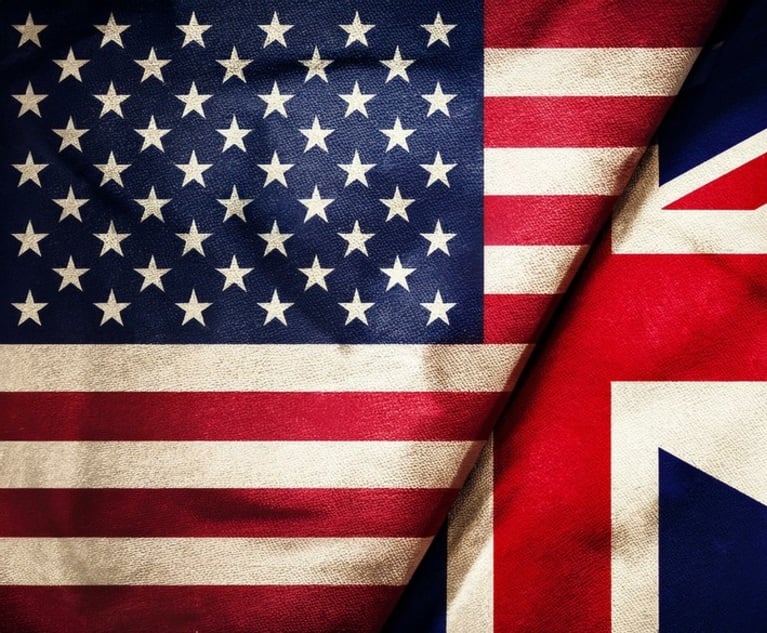Global law firm mergers and vereins: the end of the affair?
Eversheds and Wragges opted against the verein structure for their recent mergers – could its popularity be coming to an end?
March 23, 2017 at 07:04 AM
6 minute read
No one could have predicted that an obscure legal structure designed to be used by Swiss sports clubs and other non-profits would end up fundamentally reshaping the legal industry.
The Swiss verein, which allows firms to combine more easily and retain their existing forms, has been adopted in almost every major cross-border law firm tie-up of the past decade, including those that created Dentons, DLA Piper, Hogan Lovells, King & Wood Mallesons, Norton Rose Fulbright and Squire Patton Boggs. Vereins now account for five of the world's 15 largest law firms by revenue, according to The American Lawyer's Global 100 survey – including three of the top six.
But could the structure's popularity be coming to an end?
Both of the last two large-scale transatlantic combinations that required new holding structures eschewed the verein in favour of a UK law entity called 'company limited by guarantee' (CLG). In early 2016, Wragge Lawrence Graham & Co and Canada's Gowlings opted for a CLG in their merger, becoming the first Global 100 firm to use the structure. Eversheds and Sutherland Asbill & Brennan also used the CLG structure when they merged in February. (DAC Beachcroft's recently announced four-way alliance with insurance firms in the US, Germany and Australia was also structured as a CLG.)
At first glance, the choice of CLG over verein appears to be of little consequence. The two structures are remarkably similar in principle and practice. Both allow a flexible approach to governance and result in member firms that are distinct legal entities with limited liability. They also prohibit the distribution of profits across the network, although member firms can share costs, and pseudo profit-sharing is possible through contracting arrangements.
Vereins and CLGs do differ in one important area, however: risk.
Gowling WLG strategic development director Jenny Hardy told The American Lawyer that the firm initially assumed that it would use a verein for its formative combination last year. But ultimately, it decided that the CLG had "more certainty" regarding its legal position.
That's because of a fundamental – if untested – question of whether vereins are meant to be profit-seeking enterprises to begin with.
There is a risk that if the verein is used as the governance entity of a network whose members carry out commercial activities, the verein could be deemed to be invalidly incorporated
The verein structure was originally created for use by non-profit-making organisations, such as charities and societies. Indeed, the German word verein actually means 'club' or 'association'.
Aster Crawshaw, a professional practices expert at Addleshaw Goddard, said there is a lingering question over its use by commercial businesses, such as law firms. "There is a risk, albeit one that is dismissed by many Swiss lawyers, that if the verein is used as the governance entity of a network whose members carry out commercial activities, the verein could be deemed to be invalidly incorporated," he said.
If a verein were declared invalid, the network could suddenly find itself treated as a general partnership. In ordinary circumstances, this is no big deal – the legal market is filled with such businesses. But this would also mean that the member firms would lose their limited liability status and instead have unlimited joint and several liabilities. This would obviously have hugely significant implications in the event of a legal claim against one of the member firms.
Tina Williams, a partnership expert and chair of London law firm Fox Williams, said this risk has caused the verein to "fall out of favour" among commercial organisations. Big Four accounting firms KPMG and Deloitte both established vereins in the 1990s but later ditched the structure – the latter converting to a CLG in 2010. EY and PwC are also CLGs.
The public audit work carried out by accounting firms opens them up to particular risks – liability to third-party investors, for example. Law firms, on the other hand, mainly face claims from clients, and a firm's engagement with a client is typically subject to terms of business that limit liability.
Nevertheless, law firms may see CLGs as providing additional insulation. The structure is governed by the UK Companies Act, which provides CLGs with a solid and well defined legal footing, whereas vereins operate according to general principles of Swiss law that are more open to interpretation.
There is a downside to being subject to the Companies Act, however. It means CLGs must adhere to a far more extensive – and potentially arduous – set of rules than they would with a verein. The UK Companies Act is one of the longest acts in British legislative history, running to almost 700 pages; the Swiss Civil Code provisions for the verein cover a mere five pages.
CLGs also face greater public disclosure obligations, including the requirement for the network entity's accounts to be publicly available at Companies House.
The only structural rule imposed upon vereins, on the other hand, is the requirement to form a vorstand – essentially a board of directors. Almost every other aspect of a verein firm's organisation is defined by its own strategic and management decisions and not by any restrictions inherent to the structure.
And for many vereins – particularly those formed as the result of a transatlantic combination – the structure holds another, even more important attraction: jurisdictional neutrality.
"Many of the vereins in the legal sector have a large UK firm as one of the founding members, [so] using an entity incorporated in the UK as the network governance vehicle may exacerbate any impression that the network is dominated by the UK law firm," Crawshaw said. "Although largely an optical consideration, in many cases it is a more immediate issue than the technical legal risk."
As long as that legal risk stays hypothetical, in other words, the attraction of Swiss neutrality for some firms will endure. But as global consolidation in the industry continues, more firms are banking on the British model.
This content has been archived. It is available through our partners, LexisNexis® and Bloomberg Law.
To view this content, please continue to their sites.
Not a Lexis Subscriber?
Subscribe Now
Not a Bloomberg Law Subscriber?
Subscribe Now
NOT FOR REPRINT
© 2025 ALM Global, LLC, All Rights Reserved. Request academic re-use from www.copyright.com. All other uses, submit a request to [email protected]. For more information visit Asset & Logo Licensing.
You Might Like
View All
A&O Shearman, White & Case Advise on €1.2B Public Takeover of German Steel Giant Salzgitter
3 minute read

Slaughter and May and A&O Shearman Advise as Latest UK Company Goes American
3 minute read
Trio of Firms Act On Chinese Insurer Ping An's $1.7B Stake Acquisition In Healthcare Arm
Trending Stories
- 1States Accuse Trump of Thwarting Court's Funding Restoration Order
- 2Microsoft Becomes Latest Tech Company to Face Claims of Stealing Marketing Commissions From Influencers
- 3Coral Gables Attorney Busted for Stalking Lawyer
- 4Trump's DOJ Delays Releasing Jan. 6 FBI Agents List Under Consent Order
- 5Securities Report Says That 2024 Settlements Passed a Total of $5.2B
Who Got The Work
J. Brugh Lower of Gibbons has entered an appearance for industrial equipment supplier Devco Corporation in a pending trademark infringement lawsuit. The suit, accusing the defendant of selling knock-off Graco products, was filed Dec. 18 in New Jersey District Court by Rivkin Radler on behalf of Graco Inc. and Graco Minnesota. The case, assigned to U.S. District Judge Zahid N. Quraishi, is 3:24-cv-11294, Graco Inc. et al v. Devco Corporation.
Who Got The Work
Rebecca Maller-Stein and Kent A. Yalowitz of Arnold & Porter Kaye Scholer have entered their appearances for Hanaco Venture Capital and its executives, Lior Prosor and David Frankel, in a pending securities lawsuit. The action, filed on Dec. 24 in New York Southern District Court by Zell, Aron & Co. on behalf of Goldeneye Advisors, accuses the defendants of negligently and fraudulently managing the plaintiff's $1 million investment. The case, assigned to U.S. District Judge Vernon S. Broderick, is 1:24-cv-09918, Goldeneye Advisors, LLC v. Hanaco Venture Capital, Ltd. et al.
Who Got The Work
Attorneys from A&O Shearman has stepped in as defense counsel for Toronto-Dominion Bank and other defendants in a pending securities class action. The suit, filed Dec. 11 in New York Southern District Court by Bleichmar Fonti & Auld, accuses the defendants of concealing the bank's 'pervasive' deficiencies in regards to its compliance with the Bank Secrecy Act and the quality of its anti-money laundering controls. The case, assigned to U.S. District Judge Arun Subramanian, is 1:24-cv-09445, Gonzalez v. The Toronto-Dominion Bank et al.
Who Got The Work
Crown Castle International, a Pennsylvania company providing shared communications infrastructure, has turned to Luke D. Wolf of Gordon Rees Scully Mansukhani to fend off a pending breach-of-contract lawsuit. The court action, filed Nov. 25 in Michigan Eastern District Court by Hooper Hathaway PC on behalf of The Town Residences LLC, accuses Crown Castle of failing to transfer approximately $30,000 in utility payments from T-Mobile in breach of a roof-top lease and assignment agreement. The case, assigned to U.S. District Judge Susan K. Declercq, is 2:24-cv-13131, The Town Residences LLC v. T-Mobile US, Inc. et al.
Who Got The Work
Wilfred P. Coronato and Daniel M. Schwartz of McCarter & English have stepped in as defense counsel to Electrolux Home Products Inc. in a pending product liability lawsuit. The court action, filed Nov. 26 in New York Eastern District Court by Poulos Lopiccolo PC and Nagel Rice LLP on behalf of David Stern, alleges that the defendant's refrigerators’ drawers and shelving repeatedly break and fall apart within months after purchase. The case, assigned to U.S. District Judge Joan M. Azrack, is 2:24-cv-08204, Stern v. Electrolux Home Products, Inc.
Featured Firms
Law Offices of Gary Martin Hays & Associates, P.C.
(470) 294-1674
Law Offices of Mark E. Salomone
(857) 444-6468
Smith & Hassler
(713) 739-1250









